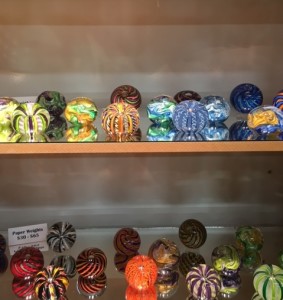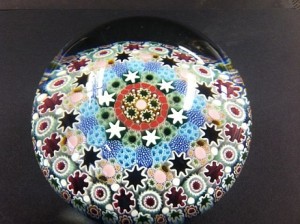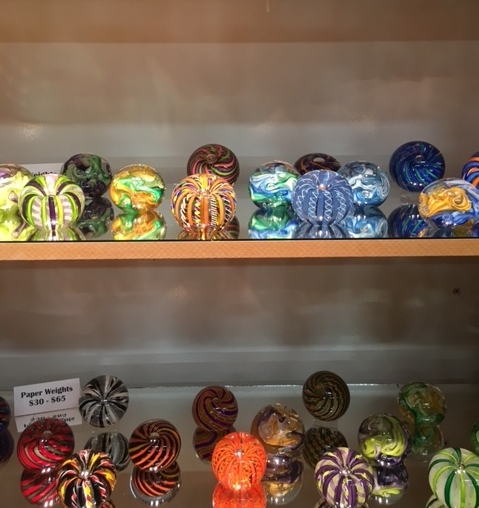
When I went to my first paperweight meeting, I didn’t know how addicted I would become to my uncommon hobby. Paperweight history and glass technology fascinate me.
Do you know hobbies are healthy for us? Do you work all the time? I’m not trying to persuade you to collect paperweights but to discover an endeavor that will bring you together with others where you meet people with similar passions. I had no idea, when I went to my first paperweight meeting, the complexity of the art.
I’m a card-carrying member of an organization for paperweight enthusiasts, but I must depend on people in my Paperweight Collectors Association of Texas for their vast knowledge. Although I’ve learned a tremendous amount, my knowledge fits in a coffee cup or maybe a thimble. Now I’m sharing my “coffee cup” with you.
Our meetings include presentations from dealers and artists. The added plus, we meet new friends who love to travel, chat, and dine together. The meetings are devoted to helping the group understand the complexity of the art. Let’s start with the basics.
Antique Paperweights
According to research, glass making began in the Middle East as long ago as 4000 BC. But let’s concentrate on more recent progress.
In an online history of paperweights, the author mentions Pietro Bigaglia, from Venice, Italy, who brought the first known paperweight to a meeting in Austria in 1845. The leaders at the St. Louis Glass Manufacturing Company in France began creating similar paperweights. Soon Baccarat, another French glass manufacturing company in France, followed. The antique paperweights often cost much more than the newer weights.
Perhaps a paperweight catches your eye in an antiques store. The price tag is $1500. Is it a good investment? If you watch the Antiques Road Show, you discover antiques can improve their value and others, not so much. For paperweights, it depends on the quality of the actual piece: pristine clarity of color, success of the artist, shape, and finish. Paperweight popularity rises and declines with the economy.
Emerging Artists

Since the 1940s American paperweight makers blossomed with methods to differentiate themselves. We call them “emerging” artists. Several styles include the millefiori or lamp work methods.
Millefiori
Millefiori (a thousand flowers) involves heating, cooling and cutting glass rods or canes. The artist inserts beautifully coordinated colorful canes in concentric patterns. Canes may look like tiny flowers, especially the rose canes. A scramble appears as it sounds: the small pieces of glass, which look a little like Christmas candy, are mixed and covered in clear glass.
Lamp Work, Flame Work and Torch Work
Ken Rosenfeld’s lamp work, for example, shows the most brilliant hues of both fruit and flowers encased in glass clearer than icy, mountain water. Although a tiny bouquet may look like straw, the entire paperweight is glass. According to one of the most respected paperweight authorities, Art Elder:
“Lamp work originated as a product of sculpting glass using the heat of a whale-oil lamp normally, used for reading. Flame work and torch work, modern terms, originated when glass became sculpted with modern fuels and torches.”
The Un-Ending Story
As the Chinese become better with their manufacturing of paperweights, the novice enthusiast must be careful to avoid purchasing counterfeits. I am not “hung up”
on paperweight values when I add to my collection. A dear friend recognized my addiction and gave me an inexpensive, Chinese weight with a pink flower, which I treasure. I love the paperweight I bought at the Corning Glass Museum gift shop created by The Glass Eye manufacturing firm in Seattle. It reminds me of a Monet painting. In Dallas the Carlyn Galerie carries the Glass Eye brand (GES on the bottom) and other less famous artists. If you are looking for an exquisite, reasonably priced object for a gift, check out retail gift shops. You may find a heart-shaped paperweight to bring joy to a friend. Kittrell/Riffkind Art Glass offers an array of art glass, including paperweights by emerging artists. Google “art glass near me” and you may find an unexpected treasure.
Click on the Paperweight Collectors of Texas website for information about our next meeting in Houston in early March. Another website for detail is the Paperweight Collectors Association, the national organization for people with a crazy affinity for paperweights as a serious art form. And if you are in an antiques store, be sure to look for paperweights. You may find a rare treasure.
